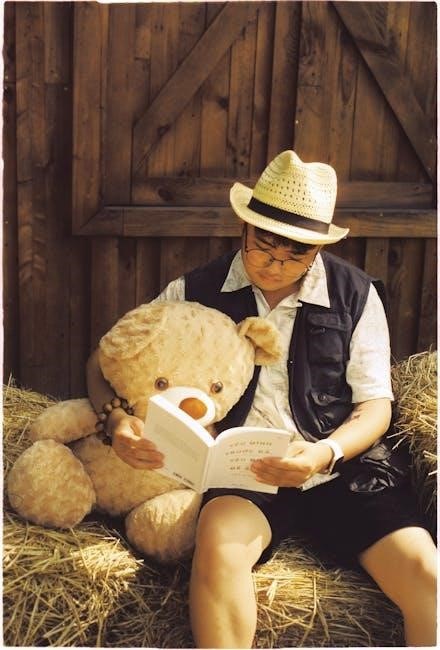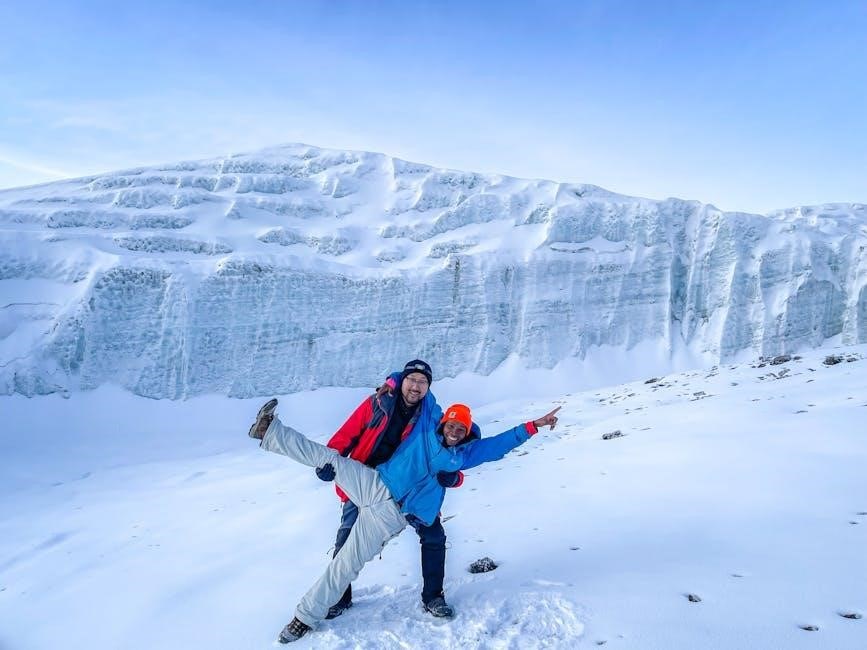
Ernest Hemingway’s “The Snows of Kilimanjaro” is a poignant short story exploring themes of regret, mortality, and artistic integrity. Set against the backdrop of an African safari, it follows Harry, a writer facing death from gangrene. His reflections reveal a life of unfulfilled potential and compromises made for comfort, symbolized by the majestic, snow-capped Kilimanjaro.
Ernest Hemingway Biography
Ernest Hemingway, born on July 21, 1899, in Oak Park, Illinois, was a towering figure in 20th-century literature, renowned for his concise and impactful writing style. His experiences in World War I, where he served as an ambulance driver, profoundly shaped his worldview and fueled his literary themes of courage, loss, and the human condition. Hemingway’s early career involved journalism, honing his skills in succinct and objective reporting, which later translated into his distinctive prose.
He lived in Paris during the “Lost Generation” era, associating with literary figures like F. Scott Fitzgerald and Gertrude Stein. This period nurtured his artistic development and solidified his commitment to writing. His novels, such as “The Sun Also Rises,” “A Farewell to Arms,” and “For Whom the Bell Tolls,” captured the disillusionment and moral complexities of his time, earning him critical acclaim and a wide readership.
Hemingway’s personal life was as eventful as his fiction, marked by multiple marriages, adventurous travels, and a deep engagement with the world. He was an avid sportsman, enjoying hunting, fishing, and bullfighting, activities that often found their way into his stories. His later years were plagued by mental health issues and physical ailments, culminating in his tragic suicide on July 2, 1961, leaving behind a legacy as one of the most influential writers of his generation.
The Snows of Kilimanjaro: Summary
“The Snows of Kilimanjaro” centers on Harry, a writer on safari in Africa, slowly dying from gangrene resulting from a neglected leg injury. Stranded with his wealthy wife, Helen, he reflects on his life, filled with regret over squandered talent and compromised artistic integrity. Harry’s memories, triggered by his impending death, juxtapose his current state with vivid recollections of past experiences, travels, and relationships. He bitterly contemplates how he prioritized comfort and financial security over pursuing his true calling as a writer.
The story interweaves Harry’s present suffering with his internal monologues, revealing his disillusionment with his choices. He criticizes Helen, his wife, for her wealth and the comfortable lifestyle that he believes has stifled his creativity. However, he also acknowledges his own culpability in his artistic decline. As Harry’s condition worsens, his memories become more intense, blurring the line between reality and imagination. He envisions himself being transported to the summit of Mount Kilimanjaro, a symbolic representation of his artistic aspirations and the purity he failed to achieve.
Ultimately, Harry succumbs to his illness. The story culminates in a poignant meditation on death, regret, and the elusive nature of artistic fulfillment, leaving the reader to ponder the consequences of choices made and opportunities lost.
The Snows of Kilimanjaro: Characters
Harry: The central character, Harry is a writer facing imminent death from gangrene. He is plagued by regret over his unfulfilled potential, blaming his choices to marry for money and comfort for stifling his artistic growth. Harry is cynical, bitter, and often cruel, particularly towards his wife, Helen. He represents the tragic figure of the artist who has compromised his integrity for material gain.
Helen: Harry’s wealthy wife, Helen, is portrayed as a kind and supportive woman, yet she becomes the target of Harry’s resentment. He blames her wealth for his artistic stagnation, although she provides him with a comfortable life and genuine affection. Helen represents the allure of a comfortable, yet ultimately unfulfilling, existence.
The Leopard: Though not a character in the traditional sense, the frozen leopard found near the summit of Kilimanjaro is a significant symbol. It represents the pursuit of unattainable goals and the futility of ambition. The leopard’s presence adds a layer of mystery and intrigue to the story.
The story primarily focuses on Harry’s internal struggles and his interactions with Helen. While other characters are mentioned in Harry’s memories, they serve mainly to illustrate his past experiences and the people who influenced his life and career. The dynamic between Harry and Helen highlights the complex relationship between love, resentment, and the pursuit of artistic fulfillment.

The Snows of Kilimanjaro: Themes
Mortality and Regret: A central theme revolves around Harry’s impending death and his profound regret over a life of unfulfilled potential. He laments the stories he never wrote, the experiences he never fully embraced, and the compromises he made for a life of comfort.
Artistic Integrity: The story explores the conflict between artistic integrity and material comfort. Harry believes his pursuit of wealth and ease has stifled his creativity and prevented him from becoming the writer he could have been. He sees his choices as a betrayal of his artistic calling.
The Corrupting Influence of Wealth: Harry blames his wealthy wife, Helen, for his artistic stagnation, suggesting that wealth can be a corrupting influence, leading to complacency and a loss of passion. However, the story also hints that Harry’s own choices and character flaws contribute to his downfall.
The Nature of Love and Relationships: The complex relationship between Harry and Helen explores the themes of love, resentment, and the challenges of maintaining intimacy in the face of personal struggles and conflicting desires. Their interactions reveal the complexities of human connection and the ways in which past experiences can shape present relationships.

The Snows of Kilimanjaro: Style
Ernest Hemingway’s writing style in “The Snows of Kilimanjaro” is characterized by its simplicity, directness, and understated emotional intensity. He employs a minimalist approach, using concise sentences and vivid imagery to create a powerful and evocative narrative.
Iceberg Theory: Hemingway’s famous “iceberg theory” is evident in the story. He presents only the surface details, leaving much of the underlying meaning and emotional weight to be inferred by the reader. This creates a sense of depth and complexity beneath the seemingly simple prose.
Stream of Consciousness: The narrative shifts between Harry’s present reality and his memories, often employing a stream-of-consciousness technique. This allows the reader to access Harry’s innermost thoughts and feelings, revealing his regrets, anxieties, and reflections on his life.
Symbolism: Hemingway uses rich symbolism throughout the story. Kilimanjaro itself symbolizes unattainable goals and the allure of the ideal. The leopard carcass represents wasted potential and the pursuit of something beyond reach. Gangrene serves as a metaphor for moral and artistic decay.
Dialogue: The dialogue is terse and realistic, reflecting the strained relationship between Harry and Helen. Their conversations reveal unspoken tensions and the emotional distance that has grown between them.
The Snows of Kilimanjaro: Historical Context
“The Snows of Kilimanjaro,” written in 1936 and published in 1938, reflects the socio-cultural landscape of the interwar period. The story emerged from a time marked by economic depression, disillusionment following World War I, and a growing sense of uncertainty about the future.
The Lost Generation: Hemingway, as a prominent member of the “Lost Generation,” captured the feelings of alienation and moral ambiguity that characterized many intellectuals and artists of this era. The story reflects this sentiment through Harry’s sense of regret and his inability to find meaning in his life.
The Rise of Modernism: The story aligns with the modernist movement in literature, which emphasized subjective experience, psychological realism, and a rejection of traditional narrative structures. Hemingway’s stream-of-consciousness technique and focus on internal conflict are hallmarks of modernism.
Colonialism and Africa: The setting of the story in Africa reflects the colonial context of the time. Africa was often depicted as a place of adventure, escape, and exoticism in Western literature. However, Hemingway also hints at the complexities and moral ambiguities of colonialism through the characters’ interactions with the landscape and local populations.
Symbolism: The Leopard on Kilimanjaro
The opening epigraph of “The Snows of Kilimanjaro,” which describes a frozen leopard found near the summit of the mountain, is rich with symbolism and open to various interpretations. The leopard’s presence at such a high altitude, far from its natural habitat, suggests a creature driven by an unattainable goal, perhaps in search of something essential that it could not find elsewhere.
Aspiration and Failure: The leopard can be seen as a symbol of human ambition and the inherent risks of striving for greatness. Its frozen state implies a failure to reach its objective, highlighting the potential for even the most determined individuals to fall short of their aspirations.
Unfulfilled Potential: In the context of the story, the leopard mirrors Harry’s own unfulfilled potential as a writer. Like the leopard, Harry possessed the talent and drive to achieve greatness, but ultimately succumbed to complacency and wasted opportunities.
Artistic Integrity: Some critics interpret the leopard as a symbol of artistic integrity. Its solitary and frozen state suggests the sacrifices and hardships that artists often endure in pursuit of their creative vision.
Harry’s Unfulfilled Potential
Harry, the protagonist of “The Snows of Kilimanjaro,” is a writer grappling with the bitter reality of his wasted talent. As he lies dying, his thoughts are consumed by the stories he never wrote and the experiences he failed to capture on paper. His potential, once brimming with promise, has been squandered through a combination of self-indulgence and poor choices.
Compromised Artistry: Harry’s decision to marry wealthy women for financial security led him away from his true calling. The comforts and distractions of a luxurious lifestyle dulled his creative edge and stifled his artistic growth.
Regret and Self-Loathing: The weight of his unfulfilled potential bears heavily on Harry as he confronts his mortality. He is filled with regret for the stories left untold and self-loathing for the compromises he made along the way.
Lost Opportunities: Harry’s memories are filled with vivid experiences that could have served as fodder for great literature. However, he failed to transform these experiences into art, leaving him with a sense of profound loss.

Gangrene as a Metaphor
In “The Snows of Kilimanjaro,” gangrene serves as a potent metaphor for the decay of Harry’s soul and the corruption of his artistic spirit. The physical ailment mirrors the moral and creative decline he has experienced throughout his life. Just as gangrene slowly consumes his flesh, Harry’s choices have eroded his potential and left him spiritually and artistically barren.
Decay of Potential: The spreading infection symbolizes the gradual deterioration of Harry’s writing abilities. His talent, once vibrant and promising, has been poisoned by complacency and a lack of dedication.
Moral Corruption: Gangrene also represents the moral decay that has taken hold of Harry. His pursuit of wealth and comfort has led him down a path of self-indulgence and compromise, leaving him morally bankrupt.
Inevitable Death: The relentless progression of the disease foreshadows Harry’s impending death, both physically and artistically. His failure to embrace his true calling has ultimately led to his demise.
Symbol of Regret: As Harry watches the gangrene consume him, he is forced to confront the consequences of his actions. The disease becomes a constant reminder of his wasted potential and the life he could have lived.

The Snows of Kilimanjaro and the Anthropocene
Interpreting “The Snows of Kilimanjaro” through the lens of the Anthropocene reveals deeper layers of meaning regarding humanity’s impact on the environment and the consequences of unsustainable lifestyles. The story, while primarily focused on individual decay, subtly reflects broader ecological concerns.
Human Impact on Nature: The African setting, once pristine, is now marred by the presence of a dying man, symbolizing humanity’s intrusion into and degradation of the natural world. The safari, a leisure activity, highlights the exploitation of nature for human enjoyment.
Mortality and Environmental Decay: Harry’s physical decay mirrors the decay of the environment. His gangrenous leg, a consequence of neglect, parallels the damage inflicted upon the planet through unsustainable practices.
Lost Connection with Nature: Harry’s detachment from the natural world reflects a broader human alienation from nature. His focus on material wealth and personal comfort has blinded him to the interconnectedness of all living things.
Symbolism of Kilimanjaro: The snow-capped mountain, a symbol of pristine wilderness, stands in stark contrast to the decaying protagonist. It serves as a reminder of what has been lost and what is at stake in the face of environmental degradation.
Critique of Consumerism: The story implicitly critiques the consumerist lifestyle that has contributed to environmental destruction. Harry’s pursuit of wealth and comfort is ultimately unsatisfying and destructive, both to himself and to the planet.
Leave a Reply
You must be logged in to post a comment.